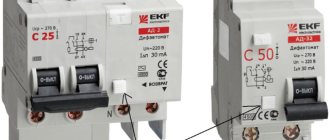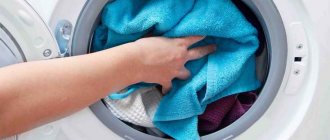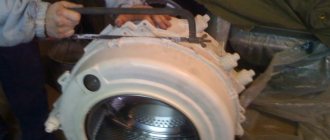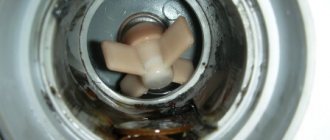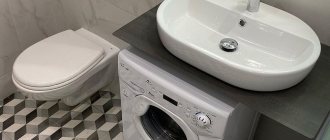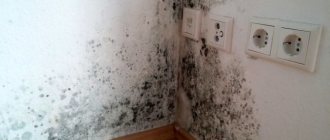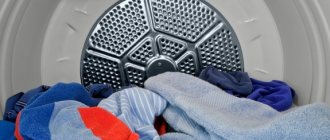Using modern household appliances such as a vacuum cleaner and an automatic washing machine, we make the task of cleaning and washing easier. When a device fails and stops performing its functions, life becomes inconvenient and difficult.
Therefore, if the washing machine does not fill with water, we quickly find the reason, otherwise the consequences can lead to the complete loss of the machine or expensive repairs.
Naturally, everyone will want to deal with the problem on their own, especially since some parts are easy to replace. But it is worth noting that if the washing machine does not fill with water, the reasons may be the most unexpected and their repair will not always be cheap.
The washing machine does not rinse well: reasons
Difficulties with rinsing things can only be discovered after the end of the washing program. A malfunction is indicated by white streaks on the laundry after removing it from the drum. Experts note popular reasons why a household washing machine does not rinse at all.
Overloaded
The permissible number of kilograms of laundry for loading is indicated on the device body. If you put more clothes in the drum, the washing powder gets stuck in the folds. Water practically cannot reach the clothes, so the product remains on the fibers.
Lots of washing powder
Why does a working washing machine perform poorly and poorly rinse your laundry? The reason is too much powder. The volume of water is simply not enough for copious amounts of household chemicals. Set the equipment to rinse again.
Hose is clogged
Waste water contains small debris - lint, dust, dirt, threads, small objects. To eliminate blockages in the drain pump, the liquid is filtered. When the filter is dirty, water is not allowed to pass through. There may be a large blockage in the pipe or pump.
Insufficient water pressure
Low water pressure occurs for two reasons:
- low pressure in the water supply system itself;
- clogged filter or water intake pipe.
In case of failures in the pumping station, the breakdown is temporary; the unit will operate normally after the pressure has stabilized. In the second case, hoses or strainers are cleaned.
Problem with water drainage
After washing, the liquid with residual powder fractions remains in the machine. The granules, mixed with clean water, penetrate the threads of the material. Drainage is disrupted when the pump is bent, clogged, or ruptured.
The heating element has failed
Control board malfunctions
The control module is responsible for executing all programs. In case of failures, the command for rinsing and spinning is not received. Only a technician can determine that it is the board that is broken.
Pressostat breakdowns
The water level sensor monitors the amount of water in the drum. The data is sent to the control board, from which the command for draining, rinsing and spinning is received. Element malfunctions lead to a complete stop of the washing process.
User errors
If the machine starts to freeze before spinning, the reason is usually that the drum is overloaded. When the maximum permissible weight is exceeded or the laundry gets bunched up, an imbalance occurs in the machine . To protect against imbalance, the machine stops working, since it cannot spin up to the required speed without risk. If at the same time the unit still tries to squeeze out a couple of revolutions, then stop the cycle, remove some of the laundry, spread the rest evenly and repeat the start.
By the way, if the drum is overloaded, poor rinsing may occur. The fact is that the powder will begin to clog into the folds. In addition, water will not be able to reach the laundry, and the cleaning agent will remain on the fibers, which leads to unpleasant stains. Often the reason that the machine does not rinse well can be an excess of powder - in this case, the volume of liquid is simply not enough to wash such a copious amount of detergent.
If the machine freezes in the rinse mode, the reason for this may be a clogged hose and filter. Waste water often contains small debris with dirt, threads, buttons and other small objects. If the water does not pass through, the machine will not spin.
This is interesting: Do-it-yourself boiler repair - causes of malfunction and solutions
The washing machine doesn’t wash things well: what happened?
Why does an automatic washing machine wash clothes and bedding very poorly? Residual stains and poor rinsing of powder occur for several reasons.
Low-quality household chemicals
Cheap washing powder does not remove stains and stains from fabric. Replace it with a quality product, but follow the dosage. If the quantity is small, the clothes are not washed, but if the quantity is larger, white spots remain.
Water problems
When an automatic washing machine does not rinse bedding and clothes well for no reason, pay attention to the water. When using hard water, rust build-up on pipes, or lack of a dirt filter, stains are not removed.
Important! Powder products dissolve poorly in hard water and hardly foam, so the use of softeners is allowed.
Pollution
Clogged washing machines lead to the appearance of dark spots or rusty marks on clothes. Sources of pollution are:
- detachment of deposits from the heater;
- pieces of mold from the walls of the tank and the seal.
Advice! To prevent mold, dry the tank after washing by opening the door.
Equipment breakdowns
Difficulties in removing contaminants arise as a result of:
Recommendations
When the Bosch code E02 appears on the display, the following tips may be useful:
- To analyze the condition of the motor, in any case, you must first remove it from the washing machine.
- The selection of spare parts should be made taking into account the model of the washing machine.
- To disassemble the washing machine, diagnose and repair, you will need a set of keys and screwdrivers, pliers, and a multimeter.
- When removing the motor brushes, you need to remember (take a photo) in what position they were originally.
The washing machine does not go into rinse mode: what to do
When your household washing machine does not switch to normal rinse mode at all, you can try to fix the problem yourself. You will need:
- Restart the washer by resetting the settings. After selecting the drain mode, the machine should start rinsing things;
- Check the drain pipe for kinks or damage. When an automatic washing machine spins and rinses poorly, the reason is a clogged hose or drain. Garbage must be removed;
- Inspect the filter for clogging and clean it. If a part is worn out, it is replaced;
How to fix it yourself?
If the washing machine does not go into normal rinse mode, you can try to deal with the problem yourself. To do this, you need to reset the settings and restart the machine - it is possible that after rebooting it starts rinsing in standard mode. If this does not have any effect, then it is worth checking the drain pipe for kinks and mechanical damage. Quite often, the cause of a breakdown is a dirt plug in the hose and a clogged sewer. To correct the error, you should remove debris and clean the filter.
If the error continues to appear, it is better to contact a specialist. Most likely, you are dealing with a technical malfunction. In order to work with mechanics and electronics, you need to have a good understanding of all the parameters declared by the manufacturer, and ordinary users, as a rule, do not have such knowledge.
Remember that in the process of self-correction of breakdowns there is always a risk of injury or rendering the equipment completely unusable.
Below, watch a video with experts explaining why the washing machine stops rinsing and what you can do yourself to solve this problem.
Features of rinsing problems in different brands
Depending on the manufacturer of the equipment, rinsing failures manifest themselves in various ways:
- Indesit devices do not rinse or wring out laundry, but washing continues without failure. The motor rotates the drum in reverse, but the program itself is extended by several minutes. At the end of the cycle, soap stains remain on things, water does not drain well from the tank;
- Bosch machines do not wring out laundry or remove waste water due to clogged drains or pump malfunctions. The door remains closed at the end of the wash. To remove things, turn off the equipment and wait 5-10 minutes;
- LG brand laundry does not rinse due to heater combustion. The program continues without stopping, the time on the timer does not change;
- Front-loading models from all brands. Washing and rinsing are not carried out due to the drum not rotating. The mechanism only malfunctions when there is excessive load.
Filter element or hose
If the machine has not started rinsing and is stuck full of water, you will first have to empty the washer. The liquid is drained through the garbage filter - at the same time this element is checked for blockages. You should proceed like this:
- unplug the machine's power cord from the outlet;
- close the tap on the water pipe;
- unhook the lower false panel or open the technical hatch (depending on the SMA model, the garbage filter is “hidden” behind one of these elements);
- place unnecessary rags around the machine;
- place a container under the bottom of the machine in the “trash bin” area to collect water;
- Unscrew the filter plug half a turn;
- collect the soapy liquid in a basin.
When the tank is empty, the door lock will unlock - then you can remove things from the drum. Next, rinse the garbage filter in warm water and shine a flashlight into the hole where it was inserted. If there is debris inside, remove it.
The garbage filter should be cleaned once every 1-2 months.
It is also necessary to feel the entire length of the drain hose, it is likely that debris has accumulated there. Having found the “lump”, clean the sleeve with a long wire bent at the end. Additionally, the corrugation is washed under the tap.
Prevention of rinsing violations
- Before storing clothes, check your pockets and remove even small fluff from them;
- Use high-quality household chemicals and water hardness control products;
- Regularly inspect filters and pumps for blockages;
- Periodically wash the machine with special products or citric acid at 90 degrees;
- When connected, switch the equipment to a separate circuit breaker;
- Load the machine slightly less than the limit specified by the manufacturer - the drum should be 1/3 free;
- Periodically use the extra rinse option;
- Check the serviceability of the heating element by touching the door glass 30 minutes after start;
- Use only powders intended for automatic washing.
Modern automatic washing machines have completely relieved housewives of such rather labor-intensive and exhausting processes as washing, rinsing, spinning, and some models even dry clothes themselves. But sometimes even such practically perfect technology malfunctions, causing the quality of washing to sharply decrease. One of the most common problems that users complain about is that the washing machine does not rinse clothes well.
"Tweaked" with the settings
Often modern machines freeze if you set the washing program incorrectly. Therefore, before starting the mode, be sure to review the instructions for the equipment. It describes the features of various functions and their compatibility with each other.
Therefore, if the washing machine stopped working precisely while running a new mode, or a previously unused combination of options, re-read the user manual. For example, ultra-modern models, if you give them the task of soaking and bleaching things, will “freeze” during the work process. Since these two commands are written in the intellect as incompatible.
Interesting:
- Whirlpool washing machine errors without display
- Kaiser washing machine errors
- Bosch dryer error codes
- Indesit washing machine stops during washing
- The washing machine is stuck on the spin cycle and won't stop.
- Electrolux washing machine frozen
Reader comments
- Share your opinion - leave a comment
How does the rinsing problem manifest itself?
It is possible to detect such a malfunction in the operation of the washing machine only after the completion of the washing cycle. If, after taking the laundry out of the drum, you find that there are white streaks left on it, this is a signal that the unit is not rinsing the powder out of the fabric fibers well.
The machine does not rinse well
And this, as we know, can lead to skin irritation and allergies. To fix the problem with rinsing, you first need to find out what is causing the problem with your machine.
Checking for damage
First you need to find out whether there is electricity in the house. After all, sometimes there is an unplanned power outage, power surges and short circuits appear, as a result of which traffic jams are knocked out. If after checking the safety circuit breaker the situation has not changed, then it is worth looking for other reasons for the breakdown.
Power failures during the operation of the machine can be characterized by a protective shutdown device, which is triggered if the housing is energized, as well as if you are shocked by an electric shock when touching the surface.
A thorough inspection of the power cord of a Bosch washing unit will allow you to determine whether there are various breaks or abrasions on it, which are formed due to numerous bends or mechanical loads. To check the integrity of the cable, you can use an electrical tester. If such defects are found on the cord, it will require further replacement.
The cause may also be a faulty socket, the suitability of which can be easily checked by simply connecting any other device.
A large number of Bosch washing machines have a power button located on the front panel. Its condition is tested using a multimeter that works as a sound emitter. After disconnecting the machine from the electrical network, select the “on” position. If the device makes a sound, it means that the current flows without interference; if the key is faulty, the tester will not emit a sound signal.
Bosch brand devices have a special network interference filter (IPF), the task of which is to neutralize electromagnetic radiation emanating from the washing machine and which can affect the correct operation of other household appliances. Often, the FPS breaks due to a long service life or a short circuit. In this case, the electrical circuit is interrupted and the flow of current practically stops, which completely destroys the entire device. To analyze the operation of this equipment in practice, a tester is used. First you should ring the entrance, and then the exit. When voltage is present at the input but not at the output, the filter must be replaced.
Why does my washing machine rinse clothes poorly?
Once again, while washing your clothes, you suddenly discover that the rinsing is not being done properly. Why is this happening?
Failure of the heating element
The reason why the automatic machine does not completely rinse the detergent from the clothes may be one of the following:
- The washing machine is overloaded. If more laundry was placed in the drum than stated by the manufacturer, the washing powder will clog into the folds of the clothes and remain on it, since practically no water gets into them.
- There was more powder than needed. In this case, the powder is poorly rinsed because the volume of rinsing water prescribed in the program is too small for the volume of detergent that has entered the drum.
- Insufficient water pressure. First, you need to understand what the reason is: either this low water pressure is associated with manipulations at the pumping station, or the problem is directly with the water supply hose going to the machine (the filter or the hose itself is clogged). In the first case, the remaining powder on the laundry is a temporary inconvenience that will go away on its own after the pressure in the water supply normalizes; the second requires cleaning the hose or filter mesh.
- Problem with water drainage. In this case, the waste water, which still contains powder, does not completely pour out of the washing machine drum. These residues are mixed with the clean water added for rinsing and, accordingly, again pass through the fibers of the fabric. The reason for this may be a clogged drain filter, a broken drain pump, or a kinked or clogged drain hose.
- The heating element has failed. Over time, the heating element becomes covered with scale and rust due to hard water. Then the washing machine stops heating the water normally, and the detergent does not dissolve completely.
Technical difficulites
No one disputes that a washing machine that constantly slows down is a rather alarming symptom, but before you panic, you need to answer a few questions.
- At what minute does the freeze occur - at the beginning of the rinse cycle, in the middle or towards the end?
- How often does freezing occur - every wash or occasionally?
- What happens to the machine in this case - does it stand still or try to spin the drum?
- Does the device respond to user commands or do they not receive any response on the board?
All these factors are very important in determining the cause of the problem. So, if a freeze occurs in the middle of the rinse cycle, then you are probably dealing with complex technical faults - damaged electronics, motor failure, program malfunctions.
The problem with freezing in the middle of the cycle is often the result of problems with the drain, pump or board. The fact is that in the rinsing mode, the used liquid must be drained several times; such circulation allows you to wash out all the remnants of the washing powder. If the water does not drain or does not enter the machine, the equipment stops working.
It often occurs in the first minute, when the SMA takes in water , but immediately drains it - that is, the rinsing process does not even begin. This usually happens when the connection to the sewer is incorrect, when all the water drains by gravity, and the device simply does not have time to heat it, sees that the liquid has run out and is immediately refilled. This error may occur if the intake valve or pressure switch is damaged.
If the program freezes at the end of the cycle, the machine is either stopped completely or the rinsing is started again - the breakdown is due to problems with the heating element or the software module. The machine may refuse to spin if the dampers are broken. When shock absorbers are faulty, the springs are unable to cope with vibration damping due to centrifugal force. As a result, the board detects a failure and automatically starts standby mode.
Pay attention to other symptoms as well. If at the moment of freezing the machine does not give any response to user commands , then this indicates problems with the electrical system - be sure to check the board for functionality; it is best to entrust the diagnostics to professionals.
If the machine stands still and does not even make any attempts to accelerate the drum, this may indicate serious damage. It is impossible to cope with such a problem on your own; you will need qualified help.
What to do if the machine does not rinse clothes well when washing
To avoid future problems with the machine not rinsing your clothes well enough, you must follow these rules:
- Do not overload the washing machine with laundry.
- Do not add more powder than the recommended amount. As the amount of clothes washed decreases, the amount of detergent used also decreases.
- When the machine begins to fill with water, check to see if all the powder has been washed out of the container. This way you can determine whether the water pressure in the tap is sufficient.
- To check the serviceability of the heating element, 20-30 minutes after the start of the wash cycle, you can touch the hatch and determine approximately whether the required temperature conditions are being maintained during rinsing.
- Use the Extra Rinse or Aqua Plus function on your machine. After completing the wash cycle, you can also rinse the laundry again using a separate “Rinse” program.
- Use fabric softeners and other fabric softeners correctly.
Checking the water supply valve
Motor brush wear
Bosch washing machines use commutator motors. The graphite brushes in them are responsible for transmitting voltage from the stator to the rotor. During operation, the brushes gradually wear out, causing the motor power to decrease. The drum cannot reach high speeds or does not rotate at all.
| Signs | How to fix | Cost* (work only) |
| The machine does not spin the drum at all or cannot reach high spin speeds. Bosch issues codes E02 or F21. | The brushes must be replaced with new ones. | from 1800 rub. |
*The cost of new brushes is not included in the price; they are paid additionally.
When you need to call a specialist
Some washing machine breakdowns simply cannot be fixed on your own. If the unit rinses clothes poorly and you don’t understand why, this may mean that it requires serious repairs.
If, after carrying out all the manipulations described above, the machine still does not rinse the clothes, you need to call a specialist to your home or take it to a service center.
The technician will figure out what the problem is, why this happened, and will be able to fix the problem.
What serious problems can interfere with high-quality rinsing:
- The water level sensor is broken. In this case, the rinse water intake mode is not observed and the sensor will need to be replaced.
- Control board malfunction. Because of this, the machine does not receive the commands specified in the washing program, and its execution stops. In this case, the control board needs to be reflashed or replaced with a new one.
But cases of serious breakdowns requiring specialist intervention are rare. By following simple rules for caring for your automatic machine and avoiding contamination of the elements, you can keep it in excellent working condition for a long time.
If you have a washing machine, most likely you have long appreciated all its benefits. Modern housewives have long forgotten what it means to wash, rinse and spin clothes by hand.
Nevertheless, even the best and high-quality washing machine is still a piece of equipment that tends to break. Quite often a situation arises when the washing machine suddenly stops during the washing process and does not rinse or spin the laundry. Why does this happen and how to eliminate the problem? Let's look at the most common reasons.
Why doesn't the heating element heat the water?
If the water in the washing equipment does not heat up, the problem is hidden in a broken heating element or a problem in the wiring. Thus, the wires in most machines (the Indesit BWSA71253WEU is no exception) are located near the body: the wiring frays over time due to vibrations created by the equipment. You will need to solder the damaged sections of the wire, but it is better to replace them with new ones.
Common Causes
- Heating element malfunction. To check the condition of the washing machine element, which heats the water for washing, you need to “ring” the tester. If the heating element is broken, it needs to be changed. It's not difficult to do it yourself. You will need to remove the back “wall” of the machine, for example, Candy CSS4 1372D3/1-S (the unit must be disconnected from the power supply), then loosen the fastenings of the installed part, dismantle it and install a new one. When replacing, you need to be careful not to damage the washer body.
- Scale. Sometimes the heating element begins to work weaker due to scale that has formed. It is enough to take out the part and clean it. To avoid this in the future, it is recommended to use special softeners or install an additional water filter.
- Relay or programmer malfunction. It is better to entrust the repair and replacement of these components to a specialist.
- Broken heating sensor. This element tells the “control” module when to start the heating element. If the sensor is broken, it will have to be replaced.
- The sensor that detects the water level is broken. A blockage in the tube (it is not difficult to clean) or wear and tear leads to breakdown - then you need to replace it.
The washing machine does not rinse clothes well
If the washing machine does not rinse the laundry or does it poorly, there may be several reasons for this, from the simplest and most banal to the complex and unpleasant. Here are a few situations when the reason does not lie in the breakdown of the unit:
Overload. If you load too much laundry into the machine, there is not enough space for the washing powder and it does not dissolve well. It gets caught in the folds of clothes and does not have enough contact with water.
A large amount of powder. Sometimes white streaks remain on laundry because the amount of powder much exceeds the volume of water provided for rinsing. To eliminate the problem, just run an additional cycle several times.
Low water pressure. Insufficient pressure occurs for two reasons:
- problems with the entire water supply system;
- The hose supplying water to the unit is clogged.
In the first case, you cannot do anything, you just need to wait until the situation improves. In the second, you need to clean the supply pipe and the filter mesh installed at the entrance to the system, the rinsing program will work again.
If none of the above is confirmed, most likely the cause of the trouble lies in a breakdown of the washing machine itself.
Damaged inlet valve
The most dangerous problem that causes the washing machine to constantly fill with water is a defect in the fill valve, which serves as a barrier between the water supply and the machine mechanism. When the “fill” command is received, the valve opens and liquid begins to be drawn into the powder compartment and further into the tank. When the chamber is full, the signal goes to the control unit, and from it back to the valve, and it closes. If it is broken, that is, it does not block the pipes, moisture will enter the system even when the device is turned off or the hatch is open. If the pressure switch is working properly, the device will drain immediately. If not, the room will be flooded. The only way to stop the flow is to shut off the pipes.
Like the previous element, this valve breaks in different ways. If only the inner membrane is faulty, flow will be weak. It can be replaced. But if the flow is strong and filling occurs quickly, it means that this part cannot be repaired, you need to install another one.
Inlet valve failure occurs in Whirlpool, Bosch and Ardo brands.
The washing machine is frozen and does not go into rinse mode
The situation looks something like this: the washing machine starts in normal mode, washes for a while, but as soon as it comes to rinsing, the program for some reason stops and goes into standby mode. First you need to find out what exactly your assistant does not want to do: rinse, wring out or pump out water.
First of all, you need to reset the current settings, select the “drain” mode and start the washer again. If nothing happens, examine the integrity of the drain hose. It is likely that it was simply twisted or pinched by something heavy. Therefore, the washing machine does not spin out the laundry. Is the hose ok? Check to see if there is a blockage in the sewer pipe. To do this, carefully disconnect the drain pipe and lower it into the bathtub or sink. If the “drain” program works, then the problem is in the plumbing.
After all the manipulations done, everything remains the same and the washing machine does not rinse or spin the clothes? This means everything is bad - the problem is in the car.
The control unit has failed
If you notice that the device does not wash clothes in the allotted time, that is, the washing mode increases several times, and at the same time the tank is filled for half an hour, then the rinsing process is delayed, a failure has occurred in the control module, which controls all processes in the device.
This breakdown occurs in Indesit and Hansa machines. Usually the control unit is carefully protected from any deformation, but in the event of a power surge or natural wear and tear, it fails. Manufacturers do not recommend opening it, cleaning contacts or performing unqualified repairs. It would be more correct to install a new part of the same brand, otherwise a software conflict will arise.
Whatever problem occurs with your equipment, the service technicians will help you deal with it. We work any time from 7:00 to 23:00. Call us at number.
The washing machine does not rinse or spin
Before you start troubleshooting, you need to turn off the power to the machine. Be sure to remove the plug from the outlet, this is very important! Now you need to forcefully empty the unit of water. This can be done through the drain filter. It is located at the bottom of the machine, behind a small panel. Now take out the laundry, you will have to rinse and wring it by hand. Everything is ready, let's start troubleshooting.
Blockage in the pump, drain filter or pipe
This is the most common answer to the question why the washing machine does not go into rinse mode or does not spin clothes well. There is a lot of debris left in the dirty water that the machine drains after washing. Sand, dust, dirt, hair, threads and small pellets and fluff. Sometimes the contents of the pockets are added to all this. Garbage clogs the drainage system and the water simply has nowhere to go. In order for rinsing to resume, you need to thoroughly clean the drain and fill filter.
Broken water level sensor
There is such a device in the washing machine - a pressure switch. It determines the water level in the unit tank. Depending on the data received from this device, the control board commands the washing process. If the water level sensor is broken, the washing machine simply “does not understand” what to do and stops.
The drain pump has become unusable
This is another reason why the rinse mode does not work, or the washing machine does not spin out things. The drain pump does not pump out water after washing and the washing machine does not rinse the clothes. The cause of the breakdown may be various objects getting into the drain pump or simply a long period of operation.
If all the hoses, filters and tubes are cleaned, the drain works as expected, and still the washing machine does not switch the rinse mode, you can find a couple more reasons for this.
The heating element burned out
If the heating element burns out, the water simply does not heat up to the set temperature. This causes the process to stop at the washing stage, and the rinsing mode simply does not have time to start. If, when setting the washing mode, you set the temperature to more than 30˚C, just touch the glass. Is it completely cold? This means that the heating element is faulty and needs to be replaced.
Control module burned out
In other words, the control board in the washing machine has become unusable. Without this part, the machine stops receiving and receiving commands, which means the rinsing mode will not turn on.
No spinning or draining of water
If there is no normal rinsing of laundry, the reasons can be sought in certain failures:
- The sensor that monitors the water level in the unit is faulty. It is based on its readings that the control unit issues commands to the remaining components of the machine so that they carry out their tasks. The inlet valve begins to draw water to the required volume and closes in a timely manner. After this, the heating element begins to bring the water to the set temperature. The engine performs a slow reverse, gradually moving to the speed necessary to spin the laundry. If the water control sensor fails, it begins to send erroneous signals to the control unit or does not operate at all. Because of this, failures occur in the programs specified on the machine:
- the machine is capable of washing, but does not rinse or spin;
- SMA collects water and immediately drains it into the sewer;
- After rinsing, the unit does not drain or spin;
- after washing, rinsing is performed, but without spinning the laundry;
- the drain filter, pipe or pump is clogged.
- Each machine has a filter element installed in front of the pump, the main task of which is to retain small objects that can damage the pump. Once the filter is full, the drain pump will not be able to pump out water. As a result, the program assigned to the machine does not switch to rinsing, or is not able to replace the specified process with spinning.
- A blockage can also form in the pipe, but this will require larger items - baby underwear, socks, etc.
- Quite often, the pump impeller gets caught in hair and threads, or it is simply jammed using a regular ear cleaning stick. In this case, the pump will not work to drain the water.
Some tips
If you want your washing machine to always please you with clean and fresh laundry, and the rinse mode to always turn on and work perfectly, follow these simple rules:
- use only high-quality detergents; cheap powders do not dissolve well in water;
- load the machine a little less than required according to the instructions, leave more free space;
- carefully check pockets and cuffs before washing, be sure to remove dirt and foreign objects;
- half an hour after the start of the washing process, touch the glass, make sure that the water in the machine has heated up to the desired temperature;
- use the “extra rinse” function without using rinse aid;
- At least once every six months, do preventative cleaning of the water intake and drainage systems, and also check the filters.
If you follow these simple rules, your home assistant will delight you with uninterrupted work for a long time.
Bearing failure
The malfunction occurs in Bosch SMAs with a service life of 5 years or more. Over time, the bearings become loose, the seal weakens, and moisture gets inside: this leads to corrosion and destruction of the bearings. The timing of breakdowns is affected by the frequency of washing and overload of the washing machine. The more often you overload the machine, the faster the bearings will fail.
| Signs | How to fix | Cost* (work only) |
| The machine makes loud sounds when operating - rattling, knocking, grinding. Especially during the spin phase. The drum may wobble when you shake it, or may not rotate at all. If you disassemble the machine, you can see rusty stains from the bearings on the tank. | The bearings and seal need to be replaced. | from 4100 rub. |
*The price does not include new bearings and oil seals, the cost is only for replacement parts
Shock absorber wear
Shock absorbers in a washing machine are needed to “absorb” vibrations during operation. When used for a long time and/or the machine is overloaded with laundry, the shock absorbers gradually fail due to which the machine begins to knock and rattle.
| Signs | How to fix | Cost* (work only) |
| The machine rattles, knocks, jumps during the spin cycle, but does not gain momentum. It is possible that knocking noises can also be heard during washing. | Worn shock absorbers are replaced with new ones.
| from 2800 rub. |
*The price is only for the work of the master, without taking into account the cost of new shock absorbers.
